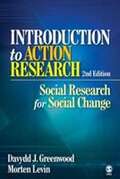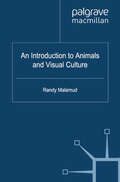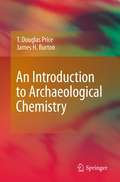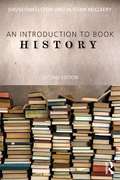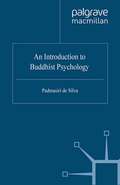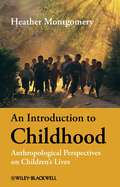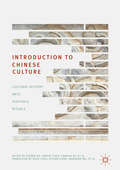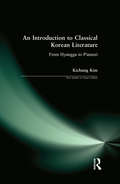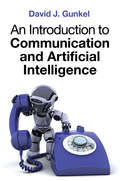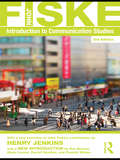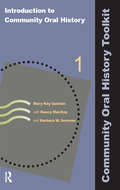- Table View
- List View
Introduction to a Social Worker (National Institute Social Services Library)
by The National Institute for Social Work TrainingOriginally published in 1964, this was an introduction to social casework, that is social work with individuals and families. It was written for students at the beginning of their training and, while intended for the social worker, it would also prove useful to other students of the social sciences and interesting to the ordinary citizen who wanted to know what social work could offer either to people in trouble or to those who adopted it as a career. The book was both authoritative and up-to-date at the time, in a field in which methods of training had evolved quite rapidly. To this its origin bears witness: the preparatory work was done by Miss Florence Mitchell, an experienced social worker and teacher of social casework. The book was shaped in consultation with other practitioners and teachers, including Dr Younghusband and Miss K. M. Lewis of the National Institute whose work had done so much to shape modern methods of training. The first chapter gives a picture of people who need the social worker’s help. It is followed by a brief survey of methods, by three chapters of case studies and by a final chapter on social work in the social services. The book thus combines a philosophy with practical guidance.
Introduction to a Social Worker (National Institute Social Services Library)
by The National Institute for Social Work TrainingOriginally published in 1964, this was an introduction to social casework, that is social work with individuals and families. It was written for students at the beginning of their training and, while intended for the social worker, it would also prove useful to other students of the social sciences and interesting to the ordinary citizen who wanted to know what social work could offer either to people in trouble or to those who adopted it as a career. The book was both authoritative and up-to-date at the time, in a field in which methods of training had evolved quite rapidly. To this its origin bears witness: the preparatory work was done by Miss Florence Mitchell, an experienced social worker and teacher of social casework. The book was shaped in consultation with other practitioners and teachers, including Dr Younghusband and Miss K. M. Lewis of the National Institute whose work had done so much to shape modern methods of training. The first chapter gives a picture of people who need the social worker’s help. It is followed by a brief survey of methods, by three chapters of case studies and by a final chapter on social work in the social services. The book thus combines a philosophy with practical guidance.
Introduction to Action Research (PDF): Social Research for Social Change
by Davydd J. Greenwood Morten LevinHow do social researchers know how to select the action research (AR) approach that is most appropriate for their study? Aimed at providing newcomers to AR with the different approaches they seek, Introduction to Action Research, 2/e introduces the history, philosophy, social change agenda, methodologies, ethical arguments for, and fieldwork tools of AR. The book opens with a brief presentation of two cases of AR. This is followed by chapter on the philosophical and methodological arguments for AR as a form of scientific inquiry that better meets scientific standards than what is currently called "social science" in academia. The authors next explore the marginalization of AR activities in academia, followed by four cases drawn from the authors own practice, including some examples of failures. Two new chapters engage the student and researcher into the current debates on action research as "tradition" or its own "methodology", and how action research takes shape in the university environment. In the final section of the book the authors cover six different approaches to doing AR. Throughout the book, the authors employ a consistent AR praxis supported by suitable methods and tools to integrate a philosophical, methodological, and political economic position to view the different kinds of AR practices. Introduction to Action Research provides experienced researchers and practitioners with more appropriate and productive ways of using AR for conducting social research.
An Introduction to African Politics
by Alex ThomsonThis fully updated fifth edition of An Introduction to African Politics is an ideal textbook for those new to the study of this fascinating continent. Charting trends in government over six decades of the post-colonial era, the book tackles key questions such as: How have African states made sense of their colonial inheritance? How relevant are ethnic and religious identities? Why have some states collapsed and others prospered? Why did the one-party state fail? Why is contemporary Africa now dominated by electoral authoritarian states, and not the multi-party democracies promised in the 1990s? Key features include: thematically organised, with chapters exploring issues such as colonialism, ethnicity, nationalism, religion, social class, ideology, legitimacy, authority, sovereignty and democracy; new five-part structure makes clearer Africa’s political evolution over time; new chapter on the emergence of ‘hybrid states’ and ‘electoral authoritarianism’; more coverage of twenty-first century governance trends such as China’s impact, the changing role of the military, different uses of ‘client–patron’ networks, Western conditionality and the ‘Africa rising’ debate; colour presentation of maps, photos and data; boxed case studies including Mali, Tanzania, Nigeria, Botswana, Côte d’Ivoire, Uganda, Somalia, Ghana, the Democratic Republic of the Congo, Tunisia and Angola; each chapter concludes with key terms and definitions, questions and further reading. An Introduction to African Politics is essential reading for students seeking an accessible introduction to the complex social relationships and events that characterise the politics of post-colonial Africa.
An Introduction to African Politics
by Alex ThomsonThis fully updated fifth edition of An Introduction to African Politics is an ideal textbook for those new to the study of this fascinating continent. Charting trends in government over six decades of the post-colonial era, the book tackles key questions such as: How have African states made sense of their colonial inheritance? How relevant are ethnic and religious identities? Why have some states collapsed and others prospered? Why did the one-party state fail? Why is contemporary Africa now dominated by electoral authoritarian states, and not the multi-party democracies promised in the 1990s? Key features include: thematically organised, with chapters exploring issues such as colonialism, ethnicity, nationalism, religion, social class, ideology, legitimacy, authority, sovereignty and democracy; new five-part structure makes clearer Africa’s political evolution over time; new chapter on the emergence of ‘hybrid states’ and ‘electoral authoritarianism’; more coverage of twenty-first century governance trends such as China’s impact, the changing role of the military, different uses of ‘client–patron’ networks, Western conditionality and the ‘Africa rising’ debate; colour presentation of maps, photos and data; boxed case studies including Mali, Tanzania, Nigeria, Botswana, Côte d’Ivoire, Uganda, Somalia, Ghana, the Democratic Republic of the Congo, Tunisia and Angola; each chapter concludes with key terms and definitions, questions and further reading. An Introduction to African Politics is essential reading for students seeking an accessible introduction to the complex social relationships and events that characterise the politics of post-colonial Africa.
An Introduction to Agricultural Geography
by David GriggEmploying nearly half of the world's workforce, agriculture is clearly of great economic and social importance. An incredible variety of methods are used globally; the Western world has the latest scientific and industrial advancements at its disposal, yet in the Thrid World a living is made using tools that have hardly changed in two thousand years. An Introduction to Agricultural Geography provides an extensive guide through this diverse and increaslingly important geographical subject, aiming to show that a wide range of factors explain how agricultural practices differ from place to place. Dealing with the physical environment, economic behaviour and demands, institutional and social influences and the impact of farming upon the environment, the author has produced an important introductory text that is topical, incisive and ultimately essential to reach an understanding of the remarkable diversity of the world's major industry.
An Introduction to Agricultural Geography
by David GriggEmploying nearly half of the world's workforce, agriculture is clearly of great economic and social importance. An incredible variety of methods are used globally; the Western world has the latest scientific and industrial advancements at its disposal, yet in the Thrid World a living is made using tools that have hardly changed in two thousand years. An Introduction to Agricultural Geography provides an extensive guide through this diverse and increaslingly important geographical subject, aiming to show that a wide range of factors explain how agricultural practices differ from place to place. Dealing with the physical environment, economic behaviour and demands, institutional and social influences and the impact of farming upon the environment, the author has produced an important introductory text that is topical, incisive and ultimately essential to reach an understanding of the remarkable diversity of the world's major industry.
Introduction to Algorithmic Government
by Rajan Gupta Saibal Kumar PalThe world is changing at a fast pace, so is the Government and Governance style. Humans are bound to go for Algorithmic strategies rather than manual or electronic ones in different domains. This book introduces the Algorithmic Government or Government by Algorithm, which refers to authorizing machines in the Public Sector for automated decision-making based on Artificial Intelligence, Data Science, and other technologies. It is an emerging concept introduced globally and will be considered revolutionary in the future. The book covers concepts, applications, progress status, and potential use-cases of Algorithmic Government. This book serves as introductory material for the readers from technology, public policy, administration, and management fields.
An Introduction to Animals and Visual Culture (The Palgrave Macmillan Animal Ethics Series)
by R. MalamudA fascinating exploration of the way in which animals are 'framed' - contextualized, decontextualized - in contemporary visual culture. Written in a highly engaging style, this book challenges the field, dealing with some highly controversial aspects of animal exploitation and boldly examines material that is seldom discussed within animal studies.
Introduction to Applied Bayesian Statistics and Estimation for Social Scientists (Statistics for Social and Behavioral Sciences)
by Scott M. LynchThis book outlines Bayesian statistical analysis in great detail, from the development of a model through the process of making statistical inference. The key feature of this book is that it covers models that are most commonly used in social science research - including the linear regression model, generalized linear models, hierarchical models, and multivariate regression models - and it thoroughly develops each real-data example in painstaking detail.
An Introduction to Applying Social Work Theories and Methods 3e
by Barbra TeaterThe text is a comprehensive guide to the most commonly used theories and methods in social work practice. The introductory chapter covers the similarities and differences between a theory and a method, as well as psychosocial theories and concepts. Each subsequent chapter then explores in detail how to implement theories and methods, their strengths and limitations, alongside case examples, critical thinking questions and suggested further resources.Key features:• Illustrative case studies • Exercises• Case examples• Critical thinking questions• Further readings/resources • Revised content, including the addition of genograms and ecomapsThis is a practical and essential guide for all social work students, practitioners, and practice educators who are working with students in field placements. The book is an updated third edition to a successful and established series.“The clarity with which Teater describes complex concepts for social workers is refreshing. This book will help promote understanding and best practice whilst being firmly grounded in key theories. It is a 'must have' for all social workers wherever they practise!”Dr Jonathan Parker, Professor of Society & Social Welfare, Bournemouth University, UK“This latest edition of 'Theories and Methods' is as solid as its predecessors academically, with a clear and easy to follow structure that makes it accessible in a way many such books are not. I have used previous editions in many situations, settings and levels, and endorse this latest as a must-have for anyone involved with social work. Explanation is clear and the use of tables, diagrams and cases bring the theory alive and enable users to realistically transfer theory to practice. The use of exercise and questions provide a springboard to deeper learning as do the handy references and pointers to further reading at the end of each chapter. Inclusion of sections such as the 'cultural and ethical considerations' lend themselves to self-analysis, exploration and ultimately self-development. A dream of a book to work with as an academic, tutor, practice educator and trainer...as well as student.”Michele Winter, Independent Social Worker & Teacher/Trainer, Social Care Training“I can wholeheartedly recommend this revised and updated edition of Barbra Teater’s highly successful book. It remains essential reading for practitioners, undergraduate and postgraduate students of social work. The book provides a compelling and easily accessible analysis of key theories and methods. It challenges both students and practitioners to consider and reconsider how they can apply theories and methods to practice more effectively.”Prof Hugh Mclaughlin, Manchester Metropolitan University, UK“What a great book – Barbra Teater and colleagues have managed to bring together a wealth of learning about different theories and methods of social work intervention in a clearly written and accessible format. Each chapter is focused on the application of theory to practice, and as such helps to act as a bridge from the classroom to direct work with individuals, families and groups. This new and updated edition is very likely to be one of those books that students have by their side throughout their studies, and bring with them into professional practice after graduation.”Dr John Devaney, Centenary Professor of Social Work, University of Edinburgh, UK
An Introduction to Archaeological Chemistry
by T. Douglas Price James H. BurtonArchaeological chemistry is a subject of great importance to the study and methodology of archaeology. This comprehensive text covers the subject with a full range of case studies, materials, and research methods. With twenty years of experience teaching the subject, the authors offer straightforward coverage of archaeological chemistry, a subject that can be intimidating for many archaeologists who do not already have a background in the hard sciences. With clear explanations and informative illustrations, the authors have created a highly approachable text, which will help readers overcome that intimidation. Topics covered included: Materials (rock, pottery, bone, charcoal, soils, metals, and others), Instruments (microscopes, NAA, spectrometers, mass spectrometers, GC/MS, XRF & XRD, Case Studies (Provinience, Sediments, Diet Reconstruction, Past Human Movement, Organic Residues). The detailed coverage and clear language will make this useful as an introduction to the study of archaeological chemistry, as well as a useful resource for years after that introduction.
Introduction to Book History
by David Finkelstein Alistair McCleeryThis second edition of An Introduction to Book History provides a comprehensive critical introduction to the development of the book and print culture. Each fully revised and updated chapter contains new material and covers recent developments in the field, including: The Postcolonial Book Censorship by states and religions Social History, and the recognition of underrepresentation of its value to book history studies Contemporary publishing Each section begins with a summary of the chapter’s aims and contents, followed by a detailed discussion of the relevant issues, concluding with a summary of the chapter and points to ponder. Sections include: the history of the book orality to Literacy literacy to printing authors, authorship and authority printers, booksellers, publishers, agents readers and reading the future of the book. An Introduction to Book History is an ideal introduction to this exciting field of study, and is designed as a companion text to The Book History Reader.
Introduction to Book History
by David Finkelstein Alistair McCleeryThis second edition of An Introduction to Book History provides a comprehensive critical introduction to the development of the book and print culture. Each fully revised and updated chapter contains new material and covers recent developments in the field, including: The Postcolonial Book Censorship by states and religions Social History, and the recognition of underrepresentation of its value to book history studies Contemporary publishing Each section begins with a summary of the chapter’s aims and contents, followed by a detailed discussion of the relevant issues, concluding with a summary of the chapter and points to ponder. Sections include: the history of the book orality to Literacy literacy to printing authors, authorship and authority printers, booksellers, publishers, agents readers and reading the future of the book. An Introduction to Book History is an ideal introduction to this exciting field of study, and is designed as a companion text to The Book History Reader.
An Introduction to Buddhist Psychology (Library of Philosophy and Religion)
by Padmasiri De SilvaAn Introduction to Buddhist Psychology is a lucid, intelligible and authentic introduction to the foundations of Buddhist psychology. It provides comprehensive coverage of the basic concepts and issues in the psychology of Buddhism and thus it deals with the nature of psychological inquiry, concepts of mind, consciousness and behaviour, motivation, emotions, perception, and the therapeutic structure of Buddhist psychology. For the fourth edition, a new chapter on 'emotional intelligence' and its relationship with Buddhism has been added.
An Introduction to Childhood: Anthropological Perspectives on Children's Lives
by Heather MontgomeryIn An Introduction to Childhood, Heather Montgomery examines the role children have played within anthropology, how they have been studied by anthropologists and how they have been portrayed and analyzed in ethnographic monographs over the last one hundred and fifty years. Offers a comprehensive overview of childhood from an anthropological perspective Draws upon a wide range of examples and evidence from different geographical areas and belief systems Synthesizes existing literature on the anthropology of childhood, while providing a fresh perspective Engages students with illustrative ethnographies to illuminate key topics and themes
Introduction to Chinese Culture: Cultural History, Arts, Festivals and Rituals
by Guobin Xu Yanhui Chen Lianhua Xu Kaiju Chen Xiyuan Xiong Wenquan WuPromoting cultural understanding in a globalized world, this text is a key tool for students interested in understanding the fundamentals of Chinese culture. Written by a team of experts in their fields, it offers a comprehensive and detailed introduction to Chinese culture and addresses the fundamentals of Chinese cultural and social development. It notably considers Chinese traditional culture, medicine, arts and crafts, folk customs, rituals and etiquette, and is a key read for scholars and students in Chinese Culture, History and Language.
Introduction to Chinese Culture: Cultural History, Arts, Festivals and Rituals
by Guobin Xu Yanhui Chen Lianhua Xu Kaiju Chen Xiyuan Xiong Wenquan WuPromoting cultural understanding in a globalized world, this text is a key tool for students interested in understanding the fundamentals of Chinese culture. Written by a team of experts in their fields, it offers a comprehensive and detailed introduction to Chinese culture and addresses the fundamentals of Chinese cultural and social development. It notably considers Chinese traditional culture, medicine, arts and crafts, folk customs, rituals and etiquette, and is a key read for scholars and students in Chinese Culture, History and Language.
An Introduction to Classical Korean Literature: From Hyangga to P'ansori
by Kichung KimThis work provides an introduction to some of the most important and representative genres of classical Korean literature. Coverage includes: Samguk sagi and samguk yusa as literature; Kunmong and Unyongchon; the lyricism of Koryo songs; and the literature of Chosen Dynasty Women.
An Introduction to Classical Korean Literature: From Hyangga to P'ansori
by Kichung KimThis work provides an introduction to some of the most important and representative genres of classical Korean literature. Coverage includes: Samguk sagi and samguk yusa as literature; Kunmong and Unyongchon; the lyricism of Koryo songs; and the literature of Chosen Dynasty Women.
An Introduction to Communication and Artificial Intelligence
by David J. GunkelCommunication and artificial intelligence (AI) are closely related. It is communication – particularly interpersonal conversational interaction – that provides AI with its defining test case and experimental evidence. Likewise, recent developments in AI introduce new challenges and opportunities for communication studies. Technologies such as machine translation of human languages, spoken dialogue systems like Siri, algorithms capable of producing publishable journalistic content, and social robots are all designed to communicate with users in a human-like way. This timely and original textbook provides educators and students with a much-needed resource, connecting the dots between the science of AI and the discipline of communication studies. Clearly outlining the topic's scope, content and future, the text introduces key issues and debates, highlighting the importance and relevance of AI to communication studies. In lively and accessible prose, David Gunkel provides a new generation with the information, knowledge, and skills necessary to working and living in a world where social interaction is no longer restricted to humans. The first work of its kind, An Introduction to Communication and Artificial Intelligence is the go-to textbook for students and scholars getting to grips with this crucial interdisciplinary topic.
Introduction to Communication Studies
by John FiskeThis revised edition of a now classic text includes a new introduction by Henry Jenkins, explaining ‘Why Fiske Still Matters’ for today’s students, followed by a discussion between former Fiske students Ron Becker, Elana Levine, Darrell Newton and Pamela Wilson on the theme of ‘Structuralism and Semiotics, Fiske-Style’. Both underline the continuing relevance of this foundational text in communication studies. How can we study communication? What are the main theories and methods of approach? This classic text provides a lucid, accessible introduction to the main authorities in the field of communication studies, aimed at students coming to the subject for the first time. It outlines a range of methods of analysing examples of communication, and describes the theories underpinning them. Thus armed, the reader will be able to tease out the latent cultural meanings in such apparently simple communications as news photos or popular TV programmes, and to see them with new eyes.
Introduction to Communication Studies (PDF)
by John FiskeThis revised edition of a now classic text includes a new introduction by Henry Jenkins, explaining ‘Why Fiske Still Matters’ for today’s students, followed by a discussion between former Fiske students Ron Becker, Elana Levine, Darrell Newton and Pamela Wilson on the theme of ‘Structuralism and Semiotics, Fiske-Style’. Both underline the continuing relevance of this foundational text in communication studies. How can we study communication? What are the main theories and methods of approach? This classic text provides a lucid, accessible introduction to the main authorities in the field of communication studies, aimed at students coming to the subject for the first time. It outlines a range of methods of analysing examples of communication, and describes the theories underpinning them. Thus armed, the reader will be able to tease out the latent cultural meanings in such apparently simple communications as news photos or popular TV programmes, and to see them with new eyes.
Introduction to Community Oral History (Community Oral History Toolkit)
by Nancy MacKay Barbara W Sommer Mary Kay QuinlanThe first book of the five-volume Community Oral History Toolkit sets the stage for an oral history project by placing community projects into a larger context of related fields and laying a sound theoretical foundation. It introduces the field of oral history to newcomers, with discussions of the historical process, the evolution of oral history as a research methodology, the nature of community, and the nature of memory. It also elaborates on best practices for community history projects and presents a detailed overview of the remaining volumes of the Toolkit, which cover Planning, Management, Interviewing, and After-the-Interview processing and curation. Introduction to Community Oral History features a comprehensive glossary, index, bibliography, and references, as well as numerous sample forms that are needed throughout the process of conducting community oral history projects.
Introduction to Community Oral History (Community Oral History Toolkit #1)
by Nancy MacKay Barbara W Sommer Mary Kay QuinlanThe first book of the five-volume Community Oral History Toolkit sets the stage for an oral history project by placing community projects into a larger context of related fields and laying a sound theoretical foundation. It introduces the field of oral history to newcomers, with discussions of the historical process, the evolution of oral history as a research methodology, the nature of community, and the nature of memory. It also elaborates on best practices for community history projects and presents a detailed overview of the remaining volumes of the Toolkit, which cover Planning, Management, Interviewing, and After-the-Interview processing and curation. Introduction to Community Oral History features a comprehensive glossary, index, bibliography, and references, as well as numerous sample forms that are needed throughout the process of conducting community oral history projects.

